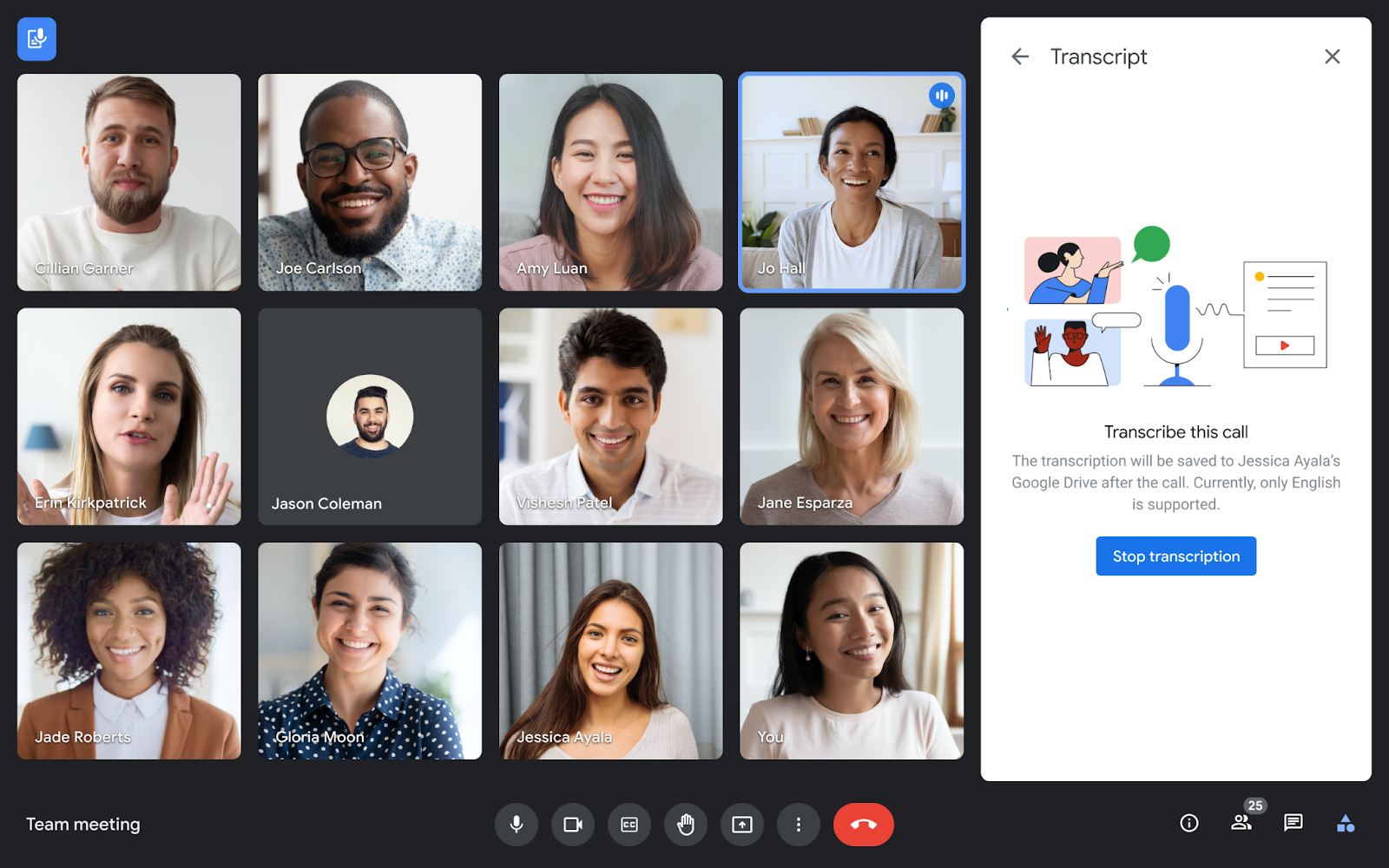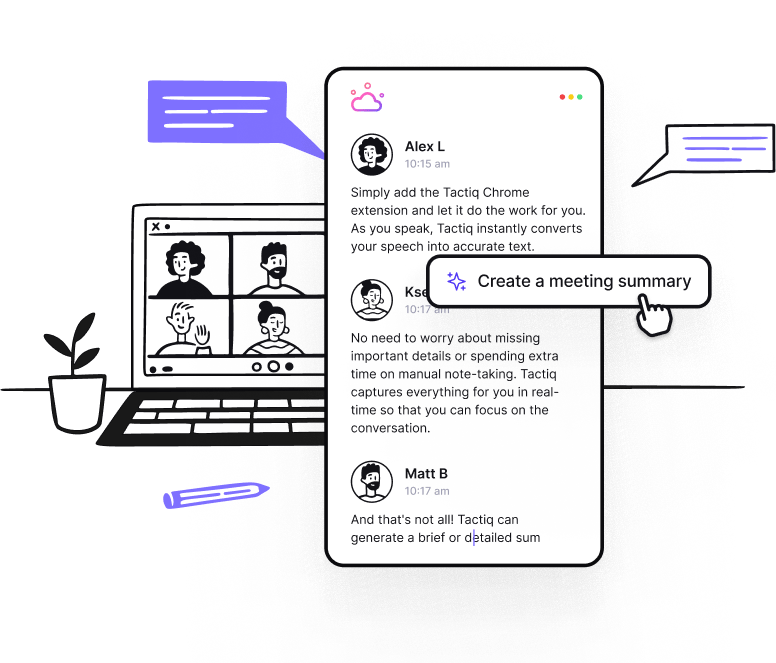Zoom vs Google Meet: Which Video Tool Wins in 2025?
September 8, 2024
September 8, 2024
June 12, 2025
June 12, 2025
Zoom and Google Meet are two of the most popular video conferencing platforms, offering unique features suitable for different types of users.
This blog breaks down the key differences to help you pick the best fit for your team in 2025.
What are the Key Differences Between Zoom and Google Meet?
Choosing between Zoom and Google Meet often comes down to understanding how their features align with your team’s needs. Both differ in pricing, collaboration tools, scalability, and accessibility. Below, we break down their key differences to help you decide which platform offers the best value for your business.
1. Pricing Comparison and Value for Money:
- Google Meet: Plans start at $6 USD per user/month (Business Starter) with a 1-year commitment. This includes 30 GB pooled storage per user, Gemini AI assistant, and 100 participant video meetings. Higher-tier plans like Business Plus ($18 USD per user/month) include 5 TB pooled storage per user, 500 participant meetings with recording and attendance tracking, and advanced management controls. The Enterprise plan supports 1,000 participants, in-domain live streaming, and S/MIME encryption (pricing on request).
- Zoom: Free Basic plan includes meetings up to 40 minutes with 100 participants. Paid plans start at €12.49/month per user (Pro), offering 30-hour meetings, AI Companion, and 5 GB cloud storage. Higher-tier plans, such as Business Plus (€19.99/month per user), add unlimited regional calling, translated captions, and workspace reservations.
Key Takeaway: Google Meet’s pricing gives it a slight edge for smaller teams and budget-conscious organizations, while Zoom provides advanced features for businesses requiring extensive integrations and scalability.
2. AI and Collaboration Features
- Google Meet: All plans include the Gemini AI assistant, which enhances meetings with enterprise-grade security, noise cancellation, appointment booking pages, and email layouts.
- Zoom: Features the Zoom AI Companion, which supports message drafting, meeting summaries, note-taking, and task automation. Advanced collaboration features like Clips allow users to create short video highlights, while Docs Unlimited supports document sharing and editing. You can also install the Zoom desktop app.
Key Takeaway: Zoom’s AI Companion focuses on enhancing productivity across meetings, chats, and emails, while Google Meet’s Gemini AI is integrated for seamless collaboration within Google Workspace.
3. Meeting Capacity and Scalability
Google Meet:
- Business Starter: Up to 100 participants.
- Business Standard: Up to 150 participants, with recording and noise cancellation.
- Business Plus: Up to 500 participants, with attendance tracking and enhanced security.
- Enterprise: Up to 1,000 participants, with in-domain live streaming.
Zoom:
- Basic and Pro: Up to 100 participants.
- Business and Business Plus: Up to 300 participants.
- Enterprise: Supports 1,000 participants with the Large Meeting Add-on (€46.50/month).
Key Takeaway: Google Meet’s tiered plans offer larger participant capacities at competitive prices, while Zoom provides scalability with add-ons.
4. Collaboration and Document Sharing
- Google Meet: Integrates seamlessly with Google Workspace tools like Gmail, Google Calendar, and Drive, enabling real-time collaboration on Docs, Sheets, and Slides during meetings.
- Zoom: Includes Docs Basic and Unlimited for document sharing and collaborative editing within the platform. Whiteboard functionality starts with 3 editable boards on the Basic plan and scales to unlimited boards on Business plans.
Key Takeaway: Google Meet excels with its deep integration into Google Workspace, while Zoom provides robust in-platform collaboration tools like Docs and Whiteboards.
5. Accessibility and Inclusivity
- Google Meet: Offers live transcription, noise cancellation, attendance tracking, and in-domain live streaming on higher-tier plans.
- Zoom: Provides translated captions, advanced participant management tools, and accessibility features like live transcription.
Key Takeaway: Both platforms emphasize inclusivity, but Zoom’s translated captions and host controls cater to multilingual and complex meeting needs.
Understanding these key differences between Zoom and Google Meet can help you choose the best video conferencing platform for your specific needs.
Pricing Comparison for Google Meet and Zoom
Both Google Meet and Zoom cater to various team sizes, from individuals to enterprise organizations. Below is a breakdown of their pricing plans, features, and scalability for teams of 1 user, 10 users, 100 users, and 1,000+ users. This comparison will help you evaluate which platform offers the best value based on your team size and specific needs.

Why Choose Zoom for Large Organizations?

- Advanced Security Features: Zoom provides end-to-end encryption, which secures your online meetings by ensuring that only the meeting participants can access the content. This is crucial for organizations that handle sensitive information, such as financial data or personal employee information. Additionally, Zoom offers two-factor authentication (2FA) to add an extra layer of security, reducing the risk of unauthorized access.
- Host Management Tools: Zoom excels in offering host management features, such as waiting rooms and participant controls. Waiting rooms allow hosts to control when participants join meetings, which is ideal for preventing interruptions. Participant controls include options like muting attendees, turning off video for specific users, and even removing disruptive participants. These tools help maintain order and ensure a smooth meeting experience.

- High Participant Capacity: Zoom can accommodate up to 1,000 participants in a single meeting. This makes it suitable for large organizations that need to host town halls, webinars, or training sessions with a large number of attendees. Unlike some other platforms, Zoom's high capacity ensures that everyone who needs to join can do so without any issues.

Image from Zoom
- Extensive Integrations: Zoom integrates with over 1,500 apps, including popular tools like Slack, Microsoft Teams, and Google Drive. These integrations help streamline workflows by allowing users to schedule meetings, share files, and collaborate across different platforms without leaving the Zoom interface. It also integrates with Tactiq, a tool that enhances post-meeting productivity by using AI to create project updates, generate insightful summaries and actionable items, and easily share and export transcripts.

- Native Annotation Tool: Zoom offers a robust annotation tool, enabling participants to mark up shared content in real time. This feature is particularly valuable in collaborative environments where visual feedback and collaborative editing are essential, such as during brainstorming sessions or detailed presentations. The annotation tool enhances engagement and ensures that everyone is on the same page, making it a key asset for large organizations.
Why is Google Meet Ideal for Small Businesses and Individuals?

Image from Google
- User-Friendly Interface: Google Meet offers a straightforward and clean interface, making it easy for anyone to start or join a meeting. Unlike more complex platforms, Google Meet's minimalistic settings reduce the learning curve, allowing users to focus on their virtual meetings rather than figuring out how to use the software. The simplicity of Google Meet makes it accessible for small businesses and individuals who may not have dedicated IT support.

Image from Google
- Seamless Integration with Google Workspace: Google Meet integrates smoothly with other Google Workspace apps like Gmail, Google Calendar, Google Docs, and Google Drive. This integration allows users to effortlessly schedule and join meetings directly from Google Calendar and share documents from Google Drive during calls. It also integrates with Tactiq, which boosts post-meeting efficiency by leveraging AI to generate project updates, create summaries, and highlight key action items while offering easy options for sharing and exporting transcripts. For businesses already using Google Workspace, this integration streamlines workflows and improves overall productivity.
- Accessibility Features: Google Meet includes built-in accessibility features such as easy-to-enable closed captioning and live transcription. Closed captioning helps participants who are deaf or hard of hearing follow along with the conversation. Live transcription provides real-time text of what is being said, which can also be useful for participants who prefer reading to listening or taking notes. These features make Google Meet an inclusive tool that supports diverse user needs. For those seeking enhanced real-time transcription and automatic meeting summaries, integrating Tactiq AI into your Zoom or Google Meet sessions can elevate the accessibility experience even further.

- Cost-Effective Pricing Plans: Google Meet’s paid plans start at $6 per user per month. This cost-effective option makes it accessible for small businesses and individuals who may be budget-conscious. The basic plan includes essential features like video conferencing, screen sharing, and integration with Google Workspace. For those needing more advanced features, higher-tier plans are available but still remain competitively priced.
Why Choose Zoom for Teaching and Students
Zoom is an excellent choice for teachers and students, offering features specifically designed to enhance the educational experience. Its advanced annotation tools and whiteboard feature make it easy for educators to engage with students in a virtual classroom. Teachers can annotate directly on shared screens, allowing for real-time feedback and interactive learning sessions. The whiteboard feature enables collaborative problem-solving, where both teachers and students can draw, write, and brainstorm together.
Moreover, Zoom offers an educational plan tailored to the needs of schools and universities. This plan includes discounted pricing, additional security features, and the ability to host large online classes, making it a cost-effective and secure solution for educational institutions. With these features, Zoom not only facilitates a more interactive and engaging learning environment but also ensures that educators and students have the tools they need for successful remote education.
{{rt_cta_ai-convenience}}
How to Enhance Your Meetings with Tactiq

Tactiq is a tool that enhances your online meetings by providing real-time transcriptions and AI-generated summaries. Here’s how it can improve your Google Meet and Zoom meetings:
- Instant Transcriptions and AI Summaries: Tactiq provides real-time transcriptions and generates AI summaries during meetings, ensuring you capture key points without manual note-taking. This also eliminates waiting times, allowing immediate review and sharing of content.
- AI Meeting Kits and Prompts: It offers AI meeting kits and customizable prompts to streamline follow-up tasks, such as writing Jira tickets or emails, making your workflow more efficient.
- Post-Meeting Follow-Up: Tactiq’s AI-powered assistant creates detailed summaries and follow-up emails, reducing the time and effort needed for post-meeting tasks.
- Seamless Integration: Tactiq integrates with Zoom and other productivity tools, automating follow-up activities with reusable one-click actions, ensuring you maximize your meeting productivity.
Post-meeting follow-ups become more efficient with Tactiq’s actionable insights. This means you can draft emails, create agendas, and log tasks in just a few clicks.
Download the free Tactiq Chrome Extension today!
Google Meet: The Cost-Optimized Solution for 2025
When it comes to choosing between Zoom and Google Meet, the decision ultimately depends on your team’s size, budget, and specific collaboration needs. However, Google Meet emerges as the cost-optimized solution for businesses looking for affordability without compromising on essential features.
- Affordable Plans for All Team Sizes: Google Meet’s tiered pricing starts at just $6 per user/month, offering robust functionality at an entry-level cost. Even its higher-tier plans, like Business Plus, provide excellent value with features like 500-participant meetings, 5 TB storage per user, and advanced security controls.
- Integrated AI Tools: With the Gemini AI assistant included in all plans, Google Meet enhances productivity through features like noise cancellation, email layouts, and appointment booking pages.
- Seamless Workspace Integration: For organizations already using Google Workspace, Google Meet is a natural choice. Its integration with tools like Gmail, Calendar, Docs, and Drive simplifies workflows and minimizes the need for additional software.
- Scalability Without High Costs: Unlike Zoom, which relies on add-ons to scale participant capacity, Google Meet’s higher-tier plans include larger meeting capacities by default.
Google Meet delivers a competitive balance of features, affordability, and collaboration-enhancing tools. For organizations prioritizing cost-effectiveness in 2025, Google Meet is the smarter choice.
Google Meet offers lower entry-level pricing, starting at $6 per user per month, making it ideal for small teams and budget-conscious organizations. Zoom’s plans start higher but provide advanced features and scalability for businesses needing extensive integrations, so you can choose the best fit based on your team size and needs.
Zoom’s AI Companion helps you draft messages, summarize meetings, and automate tasks, boosting productivity across meetings and chats. Google Meet’s Gemini AI assistant is built into all plans, enhancing collaboration within Google Workspace and streamlining your workflow.
Zoom offers advanced security, host management tools, and supports up to 1,000 participants with add-ons, making it suitable for large-scale meetings and webinars. You benefit from extensive integrations and real-time annotation tools, ensuring secure, interactive, and well-managed sessions.
Google Meet’s user-friendly interface and seamless integration with Google Workspace apps make it easy to start or join meetings and collaborate on documents. Its cost-effective plans and built-in accessibility features help you stay productive and inclusive without extra complexity.
Tactiq provides real-time transcriptions and AI-generated summaries, so you never miss key points and can skip manual note-taking. You can instantly review, share, and act on meeting insights, making your follow-up tasks faster and more efficient.
Want the convenience of AI summaries?
Try Tactiq for your upcoming meeting.
Want the convenience of AI summaries?
Try Tactiq for your upcoming meeting.
Want the convenience of AI summaries?
Try Tactiq for your upcoming meeting.









